Your Shopping Bag is Empty
Insider
LE CREUSET VOLCANIC: THE STORY OF A KITCHEN ICON
Le Creuset needs no introduction it’s that fiery-hued casserole dish every foodie covets. Useful for cooking all kinds of dishes, these prized pots have inspired cooks for generations. Here we look back at the story of how Le Creuset and their most iconic collection was born as well as celebrating the amazing new cookware just landed from the Volcanic collection which will inspire a whole new generation.
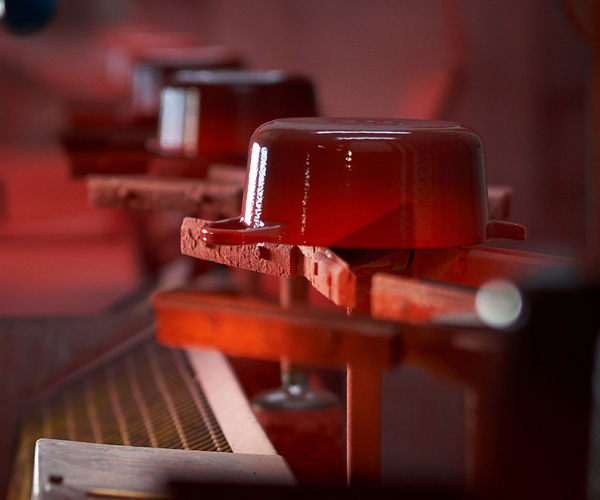
A MEETING OF MINDS
The story began back in 1925 when two Belgian industrialists met— one, a specialist in enamelling; the other, an expert in casting. Together they married their skills and invented the modern, enamel-covered icon we know today. They did this by pairing a method of casting metal using sand moulds (rather than clay) with layers of colourful, high-quality porcelain enamel, a process they developed in their foundry in the village of Fresnoy-le-Grand, situated north of Paris, where the factory is still based.
HOW THE DESIGN DEVELOPED
The design was based on traditional Dutch ovens, cookware designed to create many different dishes from stews to breads over an open flame. The Le Creuset version differed with features that included large looped handles; a wide, flat bottom; and smooth enamel covering in both the interior and the exterior for easy upkeep. Today, the icon is still crafted from the highest quality materials, and passes through at least 15 pairs of skilled craftsmen’s hands to finish and inspect each piece ensuring an exceptional quality.
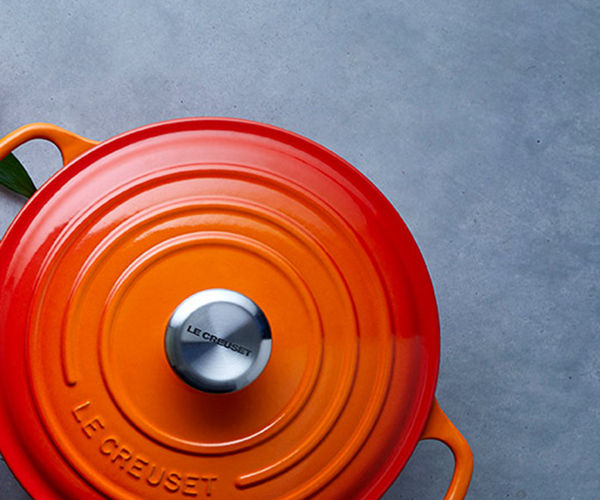
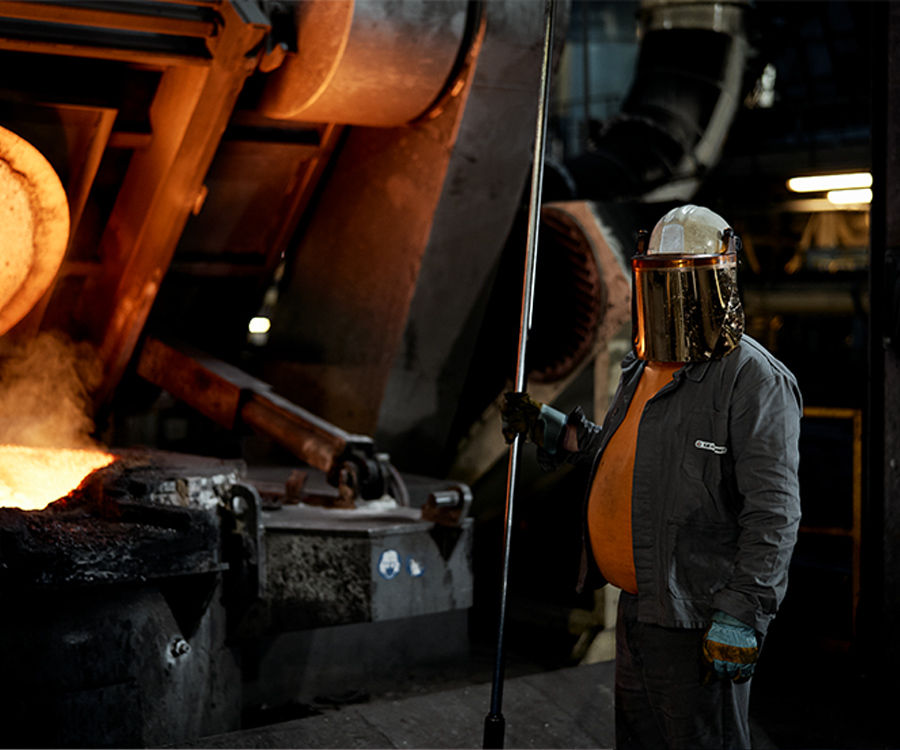
THE VOLCANIC FLAME
Inspired by the fiery orange colour of cast iron when molten, Desaegher and Aubecq’s named their first enamel colour — Volcanic Flame, it has since become the signature hue we think of when we think of the brand. Bold, bright and energising it brings joy wherever it is used, the new collection continuing to be a must-have in the modern kitchen.

"V olcanic is a true classic that has transcended trends and generations and it makes as much of a statement today as it did almost a century ago. That’s why we’ve been inspired to go back to our most iconic colour introducing new pieces in this iconic colourway.” - Le Creuset

CHOOSE YOUR CASSEROLE
Discover the benefits of the Round, Oval or Shallow Le Creuset pot and find amazing recipes to try in each.
THE ROUND CASSEROLE
The essential kitchen classic from Le Creuset enhances the cooking process by evenly distributing heat and locking in the optimal amount of moisture. Ideal for simmering tender and succulent one-pot casseroles; as well as for stews, roasting, preparing soups and rice dishes, and even baking bread and cakes.
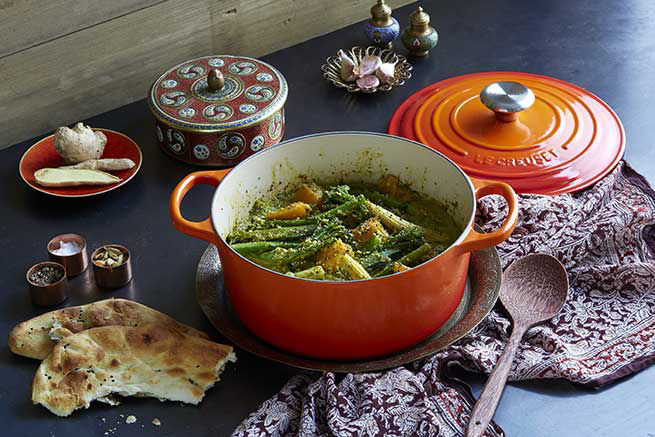
This bold and unique combination of ingredients makes the perfect dish to please everyone from vegetarians to meat-eaters alike. With plenty of flavour, the sauce is rich and creamy, without being overpowering, and you can add your own favourite vegetable combination to the dish also.
Ingredients
- 500g peeled butternut squash, cut into 1 inch thick x 2 inch long chunks
- 150g baby corn
- 300g Tenderstem broccoli, thicker stems halved lenthways
- 2 medium sized onions, roughly chopped
- 100g whole pistachios
- 50g fresh coriander, including stalks
- 6 green cardamom pods, crushed and black seeds retained, husks discarded
- 2 long red chillies
- 3 inches of fresh ginger, peeled and roughly chopped
- 5 fat garlic cloves, peeled
- 2 tablespoons of coarse black pepper
- Sea salt
- Vegetable oil
Method
- Add the vegetable oil to the casserole, just enough to coat the base, and heat gently over a low to medium heat.
- In a blender, blitz the coriander, cardamom seeds, chillies, ginger, garlic and pistachios together with enough water to generously cover them all and blend until the mixture is evenly green and smooth.
- Gently fry the onions in the casserole until softened and slightly golden then add the butternut squash and stir-fry for a minute before adding the black pepper. Pour in the pistachio curry paste and stir, then add enough room-temperature water into the pan to just about cover the ingredients. Season generously with salt to taste and reduce the heat to low and cook for a further 20 minutes.
- Check and adjust seasoning, if desired, then add the baby corn and broccoli and stir carefully. Cook for a further 10-12 minutes or until the corn and broccoli are cooked to your liking.
- Serve with rice, naan or flatbread.
THE PETITE CASSEROLE
The petite casserole is perfect for cooking and serving single portions or ‘small plate’ style side dishes. It’s also ideal for your favourite dips, condiments and nibbles. And since it’s topped with a lid, you can also use it for heating up sauces in the microwave, creating mini desserts or keeping snacks fresh. Small but mighty!
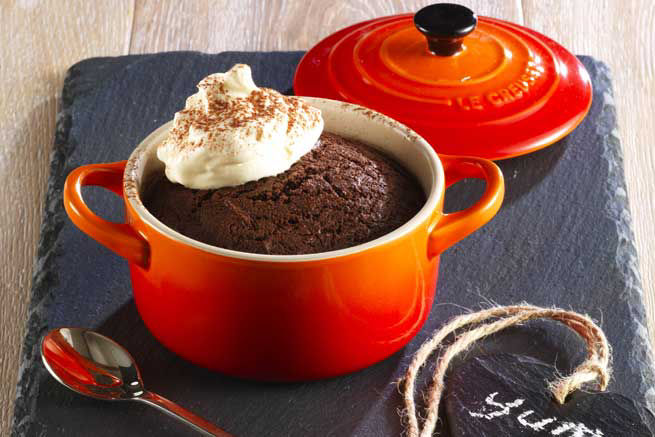
Ingredients
-
To prepare the dishes:
- 1 teaspoon butter & 1 teaspoon cocoa powder Cakes:
- 115g dark chocolate
- 115g butter
- 55g caster sugar
- 2 whole medium eggs + 2 egg yolks
- 1 teaspoon instant coffee dissolved in 1 tablespoon of water
- 1 teaspoon vanilla extract
- 80g plain flour
- 1 tablespoon cocoa powder
- Whipped cream & cocoa powder to serve
Method
- Preheat the oven: 200°C/ 400°F/ Gas Mark 6, pre-heated Fan Oven: 180°C.
- Grease the petite casseroles with butter and dust in cocoa powder.
- Melt the chocolate with the butter in a heat-proof bowl over a pan of hot water, taking care not to let the bowl touch the water.
- Whisk the sugar, eggs and egg yolks together until light and fluffy. Stir in the liquid coffee and vanilla extract.
- Whilst continuously whisking, slowly drizzle the melted chocolate and butter into the egg and sugar mixture.
- Sift in the flour with the cocoa powder and combine.
- Divide the mixture between the prepared casseroles.
- Bake for 12-14 minutes. The cakes are done when they just form a breaking crust, the mixture should be firm on top but still runny in the middle.
- Once cooked allow the cakes to stand for a minute or two.
- Serve warm with a spoonful of whipped cream and a dusting of cocoa powder.
THE SHALLOW CASSEROLE
The shallow, wide base of this versatile pot allows maximum contact between the food and the heat. It is perfect for a paella, a simple seafood linguine, couscous, sauces and more. A true 4 in 1 dish, it is a great casserole, stir-fry pan, baking dish for pies and cakes and it also makes for a stunning serving dish.

Ingredients
- 225g (8oz) plain flour + extra for rolling
- Pinch salt
- 125g (4oz) butter - chilled and cut into small cubes
- 2 tablespoon caster sugar
- 2½ tablespoons cold water
- 4 large or 5 small (approx. 650g / 1lb 7oz) crisp dessert apples
- 140g (5oz) ground almonds
- 55g (2oz) Demerara sugar + 1 tablespoon extra for dusting
- 100g (3½oz) stem ginger - drained of syrup and finely diced
- 2 tablespoons runny honey
- 3 tablespoons lemon juice
- 2½ tablespoons melted butter
- 2-3 tablespoons stem ginger syrup - for glazing
Method
- Preheat the oven to 190°C/ Fan 170°C/ 375°F/ Gas Mark 5.
- For the dough- Sift the flour and salt into a bowl, add the chilled diced butter and rub together until the mixture resembles breadcrumbs. Stir in the sugar, add the water and bring the dough together into a ball using a spatula, wrap in cling film and rest in a cool place for 1 hour.
- Peel the apples, cut into quarters and remove the cores. Cut each quarter into 3 or 4 slices and reserve. Sprinkle the apples with 2 - 3 teaspoons of the lemon juice to prevent from browning.
- Roll out the dough very thinly on a flour dusted worktop to a circle 38cm (15inches) in diameter.
- Brush the base of the casserole with a little of the melted butter and line the base and sides with the rolled out pastry, allowing the excess to stand proud of the rim.
- Combine the ground almonds, demerara sugar and chopped stem ginger together and spoon into the pastry lined pan, arrange the sliced fruit on top in a neat circle pattern starting from the centre and working outwards.
- Mix the honey with the lemon juice and brush over the top of the fruit.
- Wet the inside exposed edges of the pastry with a little water and fold it into the pan, gently pressing together where the pastry overlaps. This can be in 6 or 7 places and should look quite rustic.
- Brush the top of the turned over pastry with the melted butter and sprinkle with the extra demerara sugar.
- Bake the gallete in the centre of the preheated oven for 50 - 55 minutes until golden brown and crisp, covering it with a sheet of loose foil, once it is nicely browned.
- Remove the galette from the oven and brush the apples with the stem ginger syrup. Serve warm or at ambient temperature with vanilla custard, whipped cream, honey yogurt or ice cream.
Cook's Notes
- Other fruits such as apricots, plums, peaches, pears or a combination also work well. Cut fruit in and remove any stones or core. Leave smaller fruit in and slice larger fruit.
- As well as making a tasty filling the ground almond base absorbs the juice from the fruit as it cooks and prevents the pastry from becoming soggy.
- The back of a Le Creuset silicone spoon spatula is perfect for bringing the ingredients together; it will prevent the dough becoming warm and overworked which can result in a tough pastry. It will keep your hands clean too.
- Do not be tempted to add extra water to speed up the dough formation as this will result in the pastry becoming sticky, difficult to work with and tough.
- As sand enamel is resistant to acid; the peeled apples can be placed into the upturned lid, tossed in the lemon juice and reserved until required.
- If you have not used the lid already it is also useful as a rough size guide, the circle needs to be 4cm wider around than the whole lid.
- Use a French style rolling pin to ensure a thin, equal thickness pastry disc and push together any rough edges as you roll to ensure a neat circle.
- With sweet or enriched pastry brushing the casserole lightly with butter or coating in a light spay of baking oil will aid its release. Savoury pastry requires no preparation of the casserole but in some recipes it is used for flavour.
- If your oven has an uneven temperature turn the casserole half way through baking to ensure an even colour.
- If transferring to a serving plate allow to it cool in the casserole for a few minutes before removing as this will allow it to firm up. The dessert can be served in the casserole; the heat from baking will be retained in the cast iron which will keep it warm ready for serving.Any leftover dessert can be stored in the casserole using the lid.


